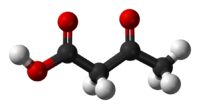- Acetoacetic acid
-
Acetoacetic acid 
 3-oxobutanoic acid, diacetic acid
3-oxobutanoic acid, diacetic acidIdentifiers CAS number 541-50-4 
PubChem 96 ChemSpider 94 
DrugBank DB04025 KEGG C00164 
ChEBI CHEBI:15344 
ChEMBL CHEMBL1230762 
Jmol-3D images Image 1 - O=C(C)CC(=O)O
Properties Molecular formula C4H6O3 Molar mass 102.09 g/mol Melting point 36.5 °C
Boiling point Decomposes
Acidity (pKa) 3.58 [1]  acid (verify) (what is:
acid (verify) (what is:  /
/ ?)
?)
Except where noted otherwise, data are given for materials in their standard state (at 25 °C, 100 kPa)Infobox references Acetoacetic acid (also called diacetic acid) is the organic compound with the formula CH3C(O)CH2CO2H. It is the simplest beta-keto acid group and like other members of this class is unstable.
Contents
Synthesis and properties
Acetoacetic acid is a weak acid (like most alkyl carboxylic acids) with a pKa of 3.77. It can be prepared by the hydrolysis of the ethyl acetoacetate followed by acidification of the anion.[2] In general, acetoacetic acid is generated at 0 °C and used in situ immediately.[3] It decomposes at a moderate rate to acetone and carbon dioxide:
- CH3C(O)CH2CO2H → CH3C(O)CH3 + CO2
The acid form has a half-life of 140 minutes at 37°C in water, whereas the basic form (the anion) has a half-life of 130 hours. That is, it reacts about 50 times more slowly.[4]
Detection
When ketone bodies are measured by way of urine concentration, acetoacetic acid, along with beta-hydroxybutyric acid (BHB), and acetone, is what is detected. This is done using dipsticks coated in nitroprusside or similar reagents. Nitroprusside changes from pink to purple in the presence of acetoacetate, the conjugate base of acetoacetic acid, and the colour change is graded by eye. The popular dipstick used to detect ketone bodies in urine "Ketostix" by Bayer, only detects acetoacetate, not BHB or acetone.
See also
References
- ^ Dawson, R. M. C., et al., Data for Biochemical Research, Oxford, Clarendon Press, 1959.
- ^ Robert C. Krueger (1952). "Crystalline Acetoacetic Acid". Journal of the American Chemical Society 74 (21): 5536–5536. doi:10.1021/ja01141a521.
- ^ George A. Reynolds and J. A. VanAllan "Methylglyoxal-ω-Phenylhydrazone" Organic Syntheses, Collected Volume 4, p.633 (1963).http://www.orgsyn.org/orgsyn/pdfs/CV4P0633.pdf
- ^ Hay, R. W.; Bond, M. A. (1967). "Kinetics of decarboxilation of acetoacetic acid". Aust. J. Chem. 20 (9): 1823–8. doi:10.1071/CH9671823.
Cholesterol and steroid metabolic intermediates Mevalonate pathway to HMG-CoAto DMAPPGeranyl-Prephytoene diphosphate · PhytoeneNon-mevalonate pathway To Cholesterol Farnesyl pyrophosphate · Squalene · 2,3-Oxidosqualene · Lanosterol
Lanosterol · Lathosterol · 7-Dehydrocholesterol · Cholesterol
Lanosterol · Zymosterol · 7-Dehydrodesmosterol · Desmosterol · CholesterolSteroid Nonhuman biochemical families: prot · nucl · carb (glpr, alco, glys) · lipd (fata/i, phld, strd, gllp, eico) · amac/i · ncbs/i · ttpy/iCategories:- Ketones
Wikimedia Foundation. 2010.
